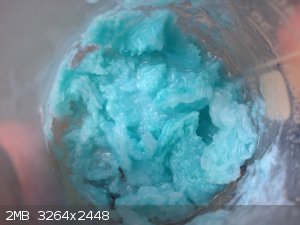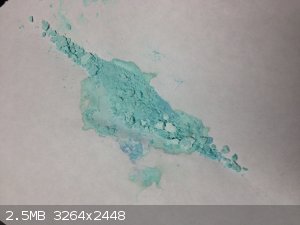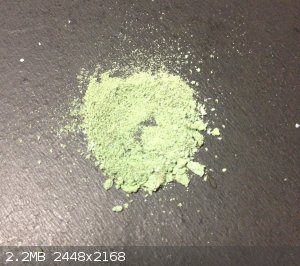Amos
International Hazard
    
Posts: 1406
Registered: 25-3-2014
Location: Yes
Member Is Offline
Mood: No
|
|
What did I just make...?
Having heard of cobalt blue pigment(cobalt(II) aluminate is a component of this), last night I decided to try to make COPPER aluminate, without having
looked into any literature first(it's fun to try things without any help first). The procedure was, I added 3g or so sodium hydroxide to a beaker with
an ice cube, which quickly melted and created a clear solution, and then I proceeded to add aluminum foil until no more would dissolve, leaving a
slightly cloudy colorless solution and a grey precipitate. I filtered out the precipitate, and with the filtrate still hot, I poured in some acidic
copper(II) sulfate solution, yielding a very voluminous icy-blue, cloudy solid at the bottom of the clear solution. Strangely, the copper sulfate
solution actually sat at the bottom, forming its own layer, until I agitated it, forming the precipitate.
Below, the first picture is of the precipitate, and the second one is the powder I obtained after first washing the precipitate in boiling water, then
filtering and drying. By now, if this solid had been copper(II) hydroxide, I would've expected it to being converting to copper(II) oxide by this
time, but no color change was seen during boiling. Deciding to find out for sure, I placed the powder directly on the surface of my hotplate at the
highest temperature for a few minutes, which turned it from a powder blue to a yellow-green-gray color, which remained after it cooled down.
Deciding to find out more information, I added some of the light blue powder first to glacial acetic acid, hydrochloric acid, and to ammonia solution.
The first two successfully dissolved MOST of the powder, yielding a blue-green solution and a yellow-green solution, respectively(the two colors one
would expect to see if a copper(II) base were added). Both of these solutions were noticeably cloudy, though, despite me having added more than enough
acid to do the job. The weak ammonia solution dissolved all of the precipitate, forming the typical color of a tetraammine copper(II) complex.
Does anyone have any ideas of what I'm dealing with here?
 
|
|
|
Metacelsus
International Hazard
    
Posts: 2531
Registered: 26-12-2012
Location: Boston, MA
Member Is Offline
Mood: Double, double, toil and trouble
|
|
It's almost definitely copper(ii) hydroxide, maybe with some trace amount of aluminum.
Solutions of sodium aluminate always have a high pH.
|
|
|
Amos
International Hazard
    
Posts: 1406
Registered: 25-3-2014
Location: Yes
Member Is Offline
Mood: No
|
|
That's what I was originally inclined to think, except that it sat, wet, open to the air for an entire night, and was subjected to temperatures in the
hundreds of degrees C and it didn't decompose to copper(II) oxide...
|
|
|
bbartlog
International Hazard
    
Posts: 1139
Registered: 27-8-2009
Location: Unmoored in time
Member Is Offline
Mood: No Mood
|
|
Would help to have some amounts beyond just the initial '3g or so of sodium hydroxide'. Supposedly there is such a thing as 'basic copper sulfate',
though whether this is actually a compound or just a mixture that is sold as an article of commerce I can't tell from a quick search.
If you weighed the inputs and your resulting blue powder carefully it would be possible to rule out certain compounds just on the basis of
stoichiometry. For example, Cu(OH)2, in addition to decomposing at higher temperatures, would also be lighter than some hypothetical
Cu3(OH)4SO4. The lack of effervescence when you added HCl also rules out CuCO3 (which would have required
impure NaOH or long air exposure for your lye solution, anyway), so I think you do have something other than simple copper hydroxide or copper
carbonate.
Your solubility experiments suggest to me that part of the precipitate is finely divided alumina.
[Edited on 23-9-2014 by bbartlog]
The less you bet, the more you lose when you win.
|
|
|
Amos
International Hazard
    
Posts: 1406
Registered: 25-3-2014
Location: Yes
Member Is Offline
Mood: No
|
|
Quote: Originally posted by bbartlog  | Would help to have some amounts beyond just the initial '3g or so of sodium hydroxide'. Supposedly there is such a thing as 'basic copper sulfate',
though whether this is actually a compound or just a mixture that is sold as an article of commerce I can't tell from a quick search.
If you weighed the inputs and your resulting blue powder carefully it would be possible to rule out certain compounds just on the basis of
stoichiometry. For example, Cu(OH)2, in addition to decomposing at higher temperatures, would also be lighter than some hypothetical
Cu3(OH)4SO4. The lack of effervescence when you added HCl also rules out CuCO3 (which would have required
impure NaOH or long air exposure for your lye solution, anyway), so I think you do have something other than simple copper hydroxide or copper
carbonate.
Your solubility experiments suggest to me that part of the precipitate is finely divided alumina.
[Edited on 23-9-2014 by bbartlog] |
The thought of redoing it again with more controlled conditions and pre-measured amounts has crossed my mind, but I'm waiting for some more copper(II)
sulfate to finish forming(I make my own).
What I can't get my head around is the ugly color that it turns upon heating; no matter how long I heat "my blue stuff" and how high past the initial
color changing temperature, it turns uniformly to that color. I'm not at home right now, but I'll upload a picture when I get there.
|
|
|
Metacelsus
International Hazard
    
Posts: 2531
Registered: 26-12-2012
Location: Boston, MA
Member Is Offline
Mood: Double, double, toil and trouble
|
|
The ugly color could be the result of a partial decomposition to CuO.
|
|
|
Amos
International Hazard
    
Posts: 1406
Registered: 25-3-2014
Location: Yes
Member Is Offline
Mood: No
|
|
That was probably what I would have said, too, without having seen it done in person myself. I've made CuO from copper hydroxide before, and the
reaction just proceeds totally differently, and much more readily, plus the greenish color I have isn't like the more blue-green/brown that I've seen
as an intermediate in CuO formation. I'll also have to check and see if the heating process reduces the mass at all when I redo it. Maybe it's just
wishful thinking but I think that what I produced might not be as obvious as it seems.
|
|
|
Amos
International Hazard
    
Posts: 1406
Registered: 25-3-2014
Location: Yes
Member Is Offline
Mood: No
|
|
So here's the stuff after heating it at about 500 degrees C for 20 minutes. I still haven't had time to try the synthesis again.

|
|
|